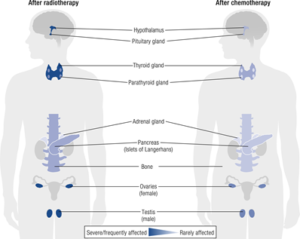During the last decade, the number of patients surviving >5 years after initial cancer treatment has significantly increased due to considerable improvements in treating many cancer entities. Currently, 400,000 childhood cancer survivors are registered in the United States and between 300,000 and 500,000 in Europe. Late endocrine disorders can occur decades after cancer treatment and affect up to 50% of childhood cancer survivors.
Endocrine sequelae of cancer therapy include functional alterations in hypothalamic-pituitary, thyroid, parathyroid, adrenal, and gonadal regulation, as well as bone and metabolic complications. Surgery, radiotherapy, chemotherapy, and immunotherapy all contribute to the development of these disorders. The hypothalamic-pituitary axis and thyroid disorders are the most common endocrine consequences after cancer therapy. The type of cancer therapy also plays a role in late endocrine complications: radiotherapy increases the risk of both endocrine insufficiencies and neoplasm occurrence within the gland where the radiation was applied. Moreover, females have more susceptibility to neoplasm development. Ionizing radiation induces DNA damage, resulting in genomic instability, chromosomal rearrangements, and cellular transformation, increasing the risk of secondary malignant neoplasm. Patients with radiation exposure directly to the head and neck and the supraclavicular or chest region are at a higher risk for primary and secondary thyroid dysfunction. Generally, children are more sensitive to radiation than adults and have a higher relative risk of cancers.
Based on recent data, 12.2% of patients with childhood brain tumors suffer from precocious puberty, indicating activation rather than reduction of pituitary function. Tumor localization and hydrocephalus were related to precocious puberty development, suggesting a local disinhibiting of puberty. Central hypogonadism may emerge decades after chemotherapy and occurs in at least 35% of patients. Severe or partial growth hormone (GH) deficiency is the most common of the pituitary axis insufficiencies after chemotherapy, as the somatotropic axis is the most vulnerable to radiation damage, leading to GH deficiency in 50-100% of childhood cancer survivors. Novel targeted chemotherapies are designed to be more targeted than conventional chemotherapeutic agents and thus induce fewer side effects. However, a wide range of possible adverse events has been reported, including endocrine and metabolic complications. Thyroid complications after chemotherapy are considerably less than after radiotherapy, respectively. Fig shows the susceptibility of endocrine organs to late complications after radiotherapy or chemotherapy. 1.
Tumors localized in the hypothalamus and/or pituitary may lead to impairment of their function due to local pressure effects, tumor growth, or surgical procedures, resulting in the development of hypopituitarism and/or diabetes insipidus.
In addition, hormonal therapies are used to treat several types of cancers derived from endocrine-responsive tissues. They include, for example, selective estrogen-response modulators used for the treatment of breast cancer and aromatase inhibitors and androgen deprivation therapies (ADTs) for prostate cancer, and they result in intended as well as adverse hormonal dysregulation.
Cancer and its therapy may affect gonadal endocrine and reproductive function in both male and female survivors. This can occur as a result of either primary gonadal damage or secondary to hypothalamic-pituitary dysfunction, leading to delayed or arrested pubertal development in children. In some patients with central late effects, precocious puberty is observed. Hypogonadism and sexual dysfunction may predispose patients to later complications such as low bone mineral density or metabolic disorders, and fertility may also be affected.
Recent data revealed a relatively increased risk for obesity in cancer survivors (specifically after cranial irradiation) and for metabolic syndrome, diabetes mellitus, and cardiovascular complications. Furthermore, cardiovascular disease has been recognized as a major cause of increased morbidity and mortality in childhood and adult cancer survivors.

Fig. 1 Susceptibility of endocrine organs for late complications after radiotherapy or chemotherapy, graded from severe/frequently affected (darkest blue) to rarely affected (lightest blue).
Hope this helps!
Best regards,
Lusine V. Navasardyan, MD, Ph.D., Associate Professor,
YSMU, Endocrinology Chair, “Arabkir” Medical Center, Pediatric Endocrinologist “ArBeS” Healthcare Center




